
Background
An unmet clinical need in Parkinson's disease (PD) is to identify biomarkers for diagnosis, preferably in peripherally accessible tissues such as skin. Immunohistochemical studies have detected pathological α-synuclein (αSyn) in skin biopsies from PD patients albeit sensitivity needs to be improved.
Objective: Our study provides the ultrasensitive detection of pathological αSyn present in the skin of PD patients, and thus, pathological αSyn in skin could be a potential biomarker for PD.
Methods
The real-time quaking-induced conversion assay was used to detect pathological αSyn present in human skin tissues. Further, we optimized this ultra-sensitive and specific assay for both frozen and formalin-fixed paraffin-embedded sections of skin tissues. We determined the seeding kinetics of the αSyn present in the skin from autopsied subjects consisting of frozen skin tissues from 25 PD and 25 controls and formalin-fixed paraffin-embedded skin sections from 12 PD and 12 controls.
Results
In a blinded study of skin tissues from autopsied subjects, we correctly identified 24/25 PD and 24/25 controls using frozen skin tissues (96% sensitivity and 96% specificity) compared to 9/12 PD and 10/12 controls using formalin-fixed paraffin-embedded skin sections (75% sensitivity and 83% specificity).
Conclusions
Our blinded study results clearly demonstrate the feasibility of using skin tissues for clinical diagnosis of PD by detecting pathological αSyn. Moreover, this peripheral biomarker discovery study may have broader translational value in detecting misfolded proteins in skin samples as a longitudinal progression marker. © 2020 International Parkinson and Movement Disorder Society.